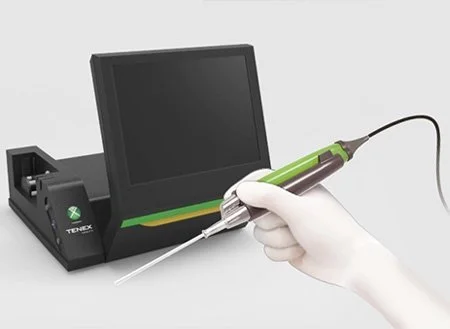
TENOTOMY
What is Tenex?
A Tenex procedure (or Tenotomy) is a minimally invasive surgical technique used to treat chronic tendinopathy, a condition characterized by pain and inflammation in tendons.
In sports medicine, Tenex is used to treat tendinopathies of the elbow (tennis elbow), shoulder (rotator cuff tendinopathy), and Achilles tendon, among others.
The procedure involves using ultrasonic energy to break down and remove damaged tissue in the tendon, leaving healthy tissue behind. The procedure is typically performed as an outpatient procedure, with minimal downtime for recovery. It is an alternative to traditional surgical procedures such as open surgery, which can have a longer recovery time.
⭐️⭐️⭐️⭐️⭐️
“Friendly staff, on time, knowledgeable and professional!
I was impressed by the care and the quick diagnosis...
ultrasound was available at my appointment
and I left with answers and relief of my pain,
with a plan for treatment moving forward.
Great care and great service. Thank you!”
Verified Zocdoc Review
Tenotomy F.A.Q.
At Arizona Sports Med, we understand that seeking medical care for a sports injury can raise many questions. To help you feel informed and prepared, we have compiled answers to some of the most common inquiries related to Tenotomy treatment for sports injuries.
-
The procedure is usually done under local anesthesia, and the surgeon makes a small incision to access the affected tendon. Then the tendon is precisely cut to release tension and allow for improved movement.
-
Tenotomy is commonly used to address conditions like tendonitis, plantar fasciitis, and tight or contracted tendons in the hand, elbow, or knee.
-
Recovery time can vary depending on the specific procedure and the individual patient. Typically, patients are advised to rest and elevate the affected area, engage in physical therapy, and follow post-operative care instructions provided by their doctor.
-
The results of tenotomy are generally long-lasting, providing relief from pain and improved function. However, individual experiences may vary, and follow-up care is essential for optimal outcomes.
-
It is crucial to have a thorough discussion with your healthcare provider to understand the potential benefits, risks, and expected outcomes of the procedure. Additionally, exploring non-surgical options and seeking a second opinion can be beneficial.

